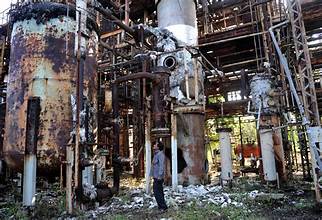Bhopal Gas Leak: Toxic Waste Finally Removed After 40 Years, Raising Health Concerns

After four decades, toxic waste from the infamous Union Carbide factory, site of the 1984 Bhopal gas tragedy, has been removed. The hazardous materials, including pesticide residue and “forever chemicals,” have been stored at the factory, leaking into surrounding groundwater and posing health risks to local communities.
In December 1984, a deadly gas leak killed thousands of people, and the site has been a significant environmental hazard ever since. On Wednesday, authorities successfully transported 337 tonnes of toxic waste to an incinerator facility 230 km away, under tight security.
While this marks progress, activists remain concerned. They argue that transporting and incinerating the waste might harm the new location’s environment and the health of nearby communities. In a previous trial in 2015, small amounts of waste destroyed at a similar plant led to soil and water contamination.
The Madhya Pradesh High Court had ordered the waste removal in December, citing the long delay in addressing the problem. While the incineration process is set to take months, the focus now shifts to the potential risks involved.
Key Issues:
- Bhopal gas leak disaster: Thousands died in the world’s deadliest industrial disaster in 1984.
- Toxic waste disposal: 337 tonnes of hazardous waste removed after decades of delay.
- Health risks: Concerns about contamination at the new disposal site.
- Environmental impact: Activists warn about further contamination affecting nearby areas.
Call for Justice:
The Bhopal disaster continues to impact survivors, with activists demanding justice for the victims, as many are still suffering from the health effects of the gas leak. Despite the 1989 settlement with Union Carbide, many argue the compensation was insufficient.
The Bhopal gas tragedy remains a symbol of industrial negligence, with lingering environmental and human consequences that continue to affect thousands.




